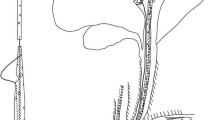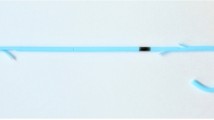Abstract
Background and Aims
The ideal pancreatic stent to prevent post-ERCP pancreatitis (PEP) has yet to be determined. The aim of our study was to assess the relative benefit of 4-Fr versus 5-Fr stents in a population at high risk for post-ERCP pancreatitis, and the relative frequency of spontaneous migration.
Patients and Methods
All patients with prophylactic pancreatic stent (PPS) from 2002 to 2009 were reviewed. Patients were classified into two groups according to stent size and compared based on outcome; spontaneous migration or endoscopic removal.
Results
A total of 346 PPS were placed in 308 patients (224 women, 84 men). The average age was 48.9 years. The most common indication for PPS was sphincter of Oddi dysfunction. Needle knife papillotomy was the most common procedure performed. Forty-seven patients had PEP, 4 Fr (14.6%) and 5 Fr (12.9%), with only one case of severe pancreatitis. Factors associated with higher rates PEP were younger age and pancreatic sphincterotomy. Complete follow-up was not available in 37 patients. Spontaneous migration was demonstrated in 115 of the 4 Fr (95.8%) and 134 of the 5 Fr (68.7%). The remaining 66 (five from the 4 Fr and 61 from the 5 Fr), were removed by endoscopy. The mean delay to demonstrate spontaneous migration was 34.2 days.
Conclusions
PPS in high-risk patients reduced the risk of post-ERCP pancreatitis and nearly eliminated severe pancreatitis. No significant difference between the 4 Fr and 5 Fr in reduction of post-ERCP pancreatitis was observed. However, spontaneous migration was more frequent with the 4-Fr stent.





Similar content being viewed by others
Abbreviations
- CT scan:
-
Computed tomography scanner
- EGD:
-
Esophagogastroduodenoscopy
- ERCP:
-
Endoscopic retrograde cholangiopancreatography
- EUS:
-
Endoscopic ultrasonography
- IL:
-
Interleukin
- KUB:
-
Plain abdominal radiography
- PD:
-
Pancreatic duct
- PPS:
-
Prophylactic pancreatic stent
- SOD:
-
Sphincter of Oddi dysfunction
References
Freeman ML, Nelson DB, Sherman S, et al. Complications of endoscopic biliary sphincterotomy. N Engl J Med. 1996;335:909–918.
Singh P, Das A, Isenberg G, et al. Does prophylactic pancreatic stent reduce the risk of post-ERCP acute pancreatitis? A meta-analysis of controlled trials. Gastrointest Endosc. 2004;60:544–550.
Freeman ML, DiSario JA, Nelson DB, et al. Risk factors for post-ERCP pancreatitis: a prospective, multicenter study. Gastrointest Endosc. 2001;54:425–434.
Tarnasky PR, Palesch YY, Cunningham JT, Mauldin PD, Cotton PB, Hawes RH. Pancreatic stenting prevents pancreatitis after biliary sphincterotomy in patients with sphincter of Oddi dysfunction. Gastroenterology. 1998;115:1518–1524.
Fazel A, Quadri A, Catalano MF, Meyerson SM, Geenen JE. Does a pancreatic duct stent prevent post-ERCP pancreatitis? A prospective randomized study. Gastrointest Endosc. 2003;57:291–294.
Brackbill S, Scott Y, Schoenfeld P, Elta G. A survey of physician practices on prophylactic pancreatic stents. Gastrointest Endosc. 2006;64:45–51.
Rashdan A, Fogel EL, McHenry L Jr, Sherman S, Temkit M, Lehman GA. Improved stent characteristics for prophylaxis of post-ERCP pancreatitis. Clin Gastroenterol Hepatol. 2004;2:322–329.
Lawrence C, Cotton PB, Romagnuolo J, Payne KM, Rawls E, Hawes RH. Small prophylactic pancreatic duct stents: an assessment of spontaneous passage and stent-induced ductal abnormalities. Endoscopy. 2007;39:1082–1085.
Cotton PB, Lehman GA, Vennes J, et al. Endoscopic sphincterotomy complications and their management: an attempt at consensus. Gastrointest Endosc. 1991;37:383–393.
Cheng CL, Sherman S, Watkins JL, et al. Risk Factors for Post-ERCP Pancreatitis: a prospective multicenter study. Am J Gastroenterol. 2006;101:139–147.
Neuhaus H. Therapeutic pancreatic endoscopy. Endoscopy. 2002;34:54–62.
Kingsnorth A. Role of cytokines and their inhibitors in acute pancreatitis. Gut. 1997;40:1–4.
Cavallini G, Tittobello A, Frulloni L, Masci E, Mariana A, Di Francesco V. Gabexate for the prevention of pancreatic damage related to endoscopic retrograde cholangiopancreatography. N Engl J Med. 1996;335:919–923.
Murray WR. Reducing the incidence and severity of post ERCP pancreatitis. Scand J Surg. 2005;94:112–116.
Akashi R, Kiyozumi T, Tanaka T, Sakurai K, Oda Y, Sagara K. Mechanism of pancreatitis caused by ERCP. Gastrointest Endosc. 2002;55:50–54.
Freeman ML. Adverse outcomes of ERCP. Gastrointest Endosc. 2002;56:S273–S282.
Hookey LC, Rio Tinto R, Delhaye M, Baize M, Le Moine O, Deviere J. Risk factors for pancreatitis after pancreatic sphincterotomy: a review of 572 cases. Endoscopy. 2006;38:670–676.
Harewood G, Pochron N, Gostout C. Prospective, randomized, controlled trial of prophylactic pancreatic stent placement for endoscopic snare excision of the duodenal ampulla. Gastrointest Endosc. 2005;62:367–370.
Tarnasky PR. Mechanical prevention of post-ERCP pancreatitis by pancreatic stents: Results, techniques, and indications. J Pancreas (Online). 2003;4:58–67.
Aizawa T, Ueno N. Stent placement in the pancreatic duct prevents pancreatitis after endoscopic sphincter dilation for removal of bile duct stones. Gastrointest Endosc. 2001;54:209–213.
Fogel EL, Eversman D, Jamidar P, Sherman S, Lehman GA. Sphincter of Oddi dysfunction. Pancreaticobiliary sphincterotomy with pancreatic stent placement has a lower rate of pancreatitis than biliary sphincterotomy alone. Endoscopy. 2002;34:280–285.
Freeman ML, Guda NM. Prevention of post-ERCP pancreatitis: a comprehensive review. Gastrointest Endosc. 2004;59:845–864.
Loperfido S, Angelini G, Benedetti G, et al. Major early complications from diagnostic and therapeutic ERCP: a prospective multicenter study. Gastrointest Endosc. 1998;48:1–10.
Masci E, Toti G, Mariani A, et al. Complications of diagnostic and therapeutic ERCP: a prospective multicenter study. Am J Gastroenterol. 2001;96:417–423.
Cohen S, Bacon BR, Berlin JA, et al. National institutes of health state-of-the-science conference statement: ERCP for diagnosis and therapy, January 14–16, 2002. Gastrointest Endosc. 2002;56:803–809.
Masci E, Mariani A, Curioni S, Testoni PA. Risk factors for pancreatitis following endoscopic retrograde cholangiopancreatography: a meta-analysis. Endoscopy. 2003;35:830–834.
Chahal P, Tarnasky P, Peterson B, et al. Short 5Fr vs. long 3Fr pancreatic stents in patients at risk for post-endoscopic retrograde cholangiopancreatography pancreatitis. Clin Gastroenterol Hepatol. 2009;7:834–839.
Freeman ML. Role of pancreatic stents in prevention of post-ERCP pancreatitis. J Pancreas (online). 2004;5:322–327.
Dumonceau JM, Rigaux J, Kahaleh M, Gomez CM, Vandermeeren A, Deviere J. Prophylaxis of post-ERCP pancreatitis: a practice survey. Gastrointest Endosc. 2010;71:934–939.
Elton E, Howell DA, Parsons WG, et al. Endoscopic pancreatic sphincterotomy: indications, outcomes, and a safe stentless technique. Gastrointest Endosc. 1998;47:240–249.
Freeman M. Pancreatic stents for prevention of post-endoscopic retrograde cholangiopancreatography pancreatitis. Clin Gastroenterol Hepatol. 2007;5:1354–1365.
Sherman S, Hawes RH, Savides TJ, et al. Stent-induced pancreatic ductal and parenchymal changes: correlation of endoscopic ultrasound with ERCP. Gastrointest Endosc. 1996;44:276–282.
Bakman YG, Safdar K, Freeman ML. Significant clinical implications of prophylactic pancreatic stent placement in previously normal pancreatic ducts. Endoscopy. 2009;41:1095–1098.
Acknowledgments
The authors would like to thank Franca Benedicty Barton, MS, for her statistical analysis and support.
Author information
Authors and Affiliations
Corresponding author
Rights and permissions
About this article
Cite this article
Pahk, A., Rigaux, J., Poreddy, V. et al. Prophylactic Pancreatic Stents: Does Size Matter? A Comparison of 4-Fr and 5-Fr Stents in Reference to Post-ERCP Pancreatitis and Migration Rate. Dig Dis Sci 56, 3058–3064 (2011). https://doi.org/10.1007/s10620-011-1695-x
Received:
Accepted:
Published:
Issue Date:
DOI: https://doi.org/10.1007/s10620-011-1695-x




